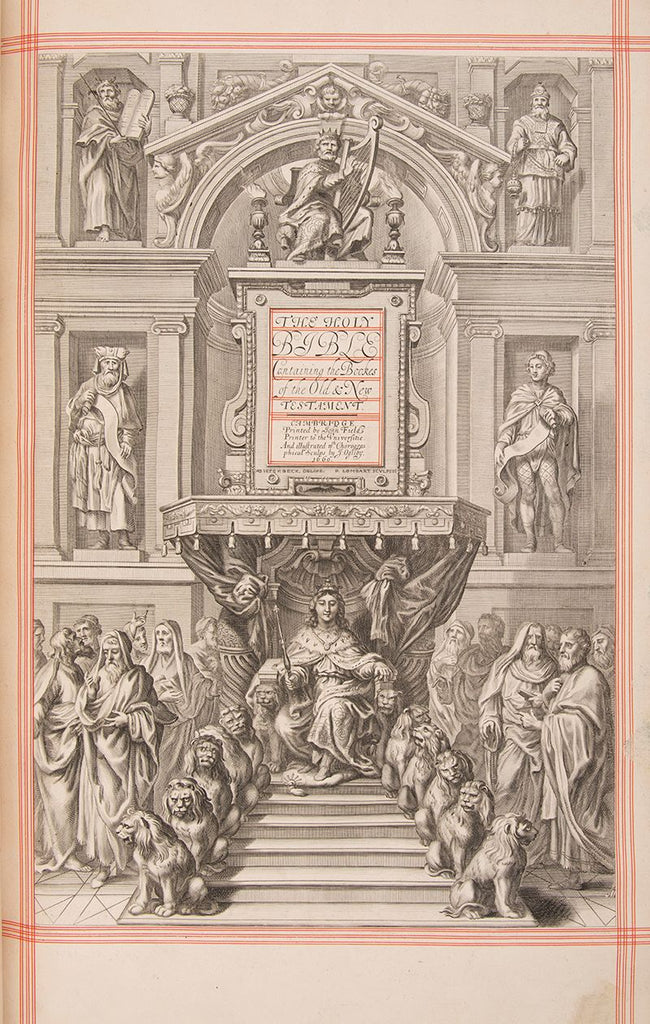The Holy Bible. Containing the Bookes of the Old and New Testament
HOLY BIBLE















Cambridge: Printed by John Field, Printer to the Universitie. 1660.
First Ogilby edition, 2 works; 2 vols; large folio (51 x 34.5 cm); 110 double-page engraved plates, including a large double-folding plan of Jerusalem, captions in Latin (some masked at time of printing), engraved general title, New Testament title dated 1659, ruled in red throughout, wide margined on thick paper, armorial bookplate to front pastedown of each vol., ownership inscription in pencil to front free endpaper, a few tears mostly affecting margins, 4N2 verso stained, minor colour-run from fore-edge throughout, some minor offsetting and ink smudges, prelims a little spotted, otherwise internally very clean; near-contemporary straight-grained red morocco, armorial device supralibros to upper boards obscured by later blue morocco panel set within gilt meander border, gilt spine in 8 compartments, alternating lettering and cross-hatch design, all edges gilt over earlier fore-edge painting of meandering vines, joints and corners expertly restored; [140], [16], 806; [2], 807-1103, [1], 258, [4], 338pp. Herbert 668; ESTC R17044; Wing B2258; Lowndes 1367; Griffiths 8.
An exceptional, well-margined copy of John Ogilby's imaginative reissue of the Field large folio bible, published for the Restoration of King Charles II on 29th May 1660.
Magnificently illustrated with 110 double-page engraved plates of biblical scenes after paintings by Rubens, Tintoretto, de Vos, de Bruyn and other old masters, including Wenceslaus Hollar's impressive double-folding-page view of Jerusalem, his Chorographica Terra Sanctae of the Holy Lands, and the engraved general title by Lombart after Diepenbeeck depicting Solomon enthroned. The work was originally illustrated with just 8 plates by Lombart and Hollar, which had been intended for the London Polyglot bible published in 1657, but Ogilby soon offered the option of embellishing the work with a choice of engravings from the Amsterdam publisher Nicolaes Visscher. The number of plates is known to vary, but ESTC calls for a total of 102 only.
The text was first published the previous year by John Field, printer to the University of Cambridge, who had been commissioned to supply a lectern bible for use in churches and libraries. The work was well-received, with the former university Vice-Chancellor John Worthington noting that 'For a fair large letter, large paper, with fair margin, &c., there was never such a Bible in being'. In the event, however, most of the edition was bought-up by Ogilby for his own project.
Variously called 'Ogilby's Bible' or 'The Restoration Bible', the result was a truly luxurious production, with well-margined copies such as this costing upwards of £25 in sheets alone. The finished work was presented to Charles II, to whom the work is dedicated, when the restored monarch first visited the Royal Chapel in Whitehall.
An 'unrivalled specimen of the press of the time', the finest edition of the Holy Bible then extant (Lowndes).
Provenance: Sir William Halsey, Gaddesden Library (bookplate and ownership inscription).
